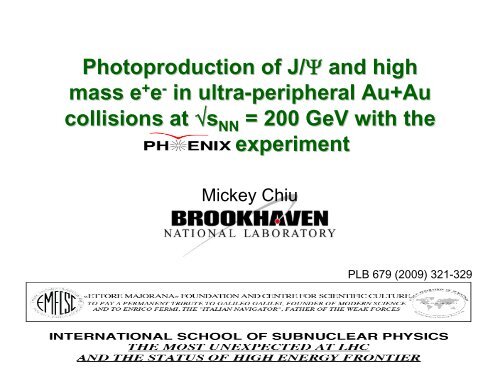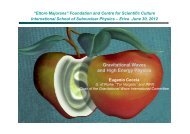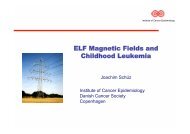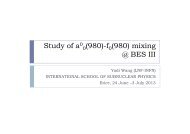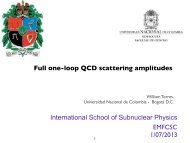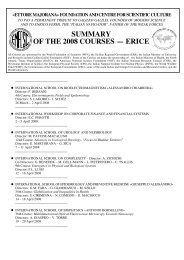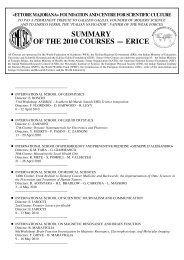in p+pbar collisions at sqrt{s}
in p+pbar collisions at sqrt{s}
in p+pbar collisions at sqrt{s}
You also want an ePaper? Increase the reach of your titles
YUMPU automatically turns print PDFs into web optimized ePapers that Google loves.
Photoproduction of J/Ψ J/ and high<br />
mass e + e- <strong>in</strong> ultra-peripheral<br />
ultra peripheral Au+Au<br />
<strong>collisions</strong> <strong>at</strong> √sNN NN = 200 GeV with the<br />
----------- experiment<br />
Mickey Chiu<br />
PLB 679 (2009) 321-329
Rel<strong>at</strong>ivistic Heavy Ion Collider,<br />
<strong>at</strong> Brookhaven N<strong>at</strong>ional<br />
Labor<strong>at</strong>ory (NY,USA)<br />
PHOBOS<br />
PHENIX PHENIX<br />
STAR<br />
RHIC experimental facility<br />
BRAHMS<br />
• Characteristics:<br />
• ~4km of circumference,<br />
• Polarized p to Au nuclei<br />
(soon U)<br />
• HIC: √sNN ~ 6-200 GeV<br />
• p+p: √s ~ 6-500 GeV<br />
Energy Density Frontier<br />
(QCD M<strong>at</strong>ter Frontier)<br />
Sp<strong>in</strong> Frontier<br />
ISSP-Erice Mickey Chiu 2/ 16
“Hadronic” Collider Processes<br />
•You’re probably familiar with the “Hadronic Interactions”<br />
•But there are a lot more processes go<strong>in</strong>g on <strong>at</strong> a hadron collider<br />
Hadronic Interaction:<br />
Au-Au --> X 6.8 barns<br />
γ-γ:<br />
AuAu --> AuAu + e + e - 33 kbarns<br />
AuAu --> AuAu + 2(e + e - ) 680 barns<br />
AuAu --> AuAu + 3(e + e - ) 50 barns<br />
γ-N: L(γ-N )=10 29 cm -2 s -1 2 Au*+Au* 3.67±0.26 barns<br />
X+neutrons<br />
Y+neutrons<br />
Hadronic Interaction<br />
Peripheral Interaction<br />
ISSP-Erice Mickey Chiu 3/ 16
Z 1 e<br />
A<br />
v~c<br />
A<br />
Z 2 e<br />
UPC A+A <strong>in</strong>teraction<br />
γ+γ and γ+A Lum<strong>in</strong>osities<br />
b > 2R<br />
RHIC, LHC L γA/L AA<br />
• The electromagnetic field is equivalent to a large flux of quasi-real photons, and<br />
can be calcul<strong>at</strong>ed per (Fermi)-Weizsacker-Williams:<br />
• Can get large flux due to the coherent effect of protons <strong>in</strong> nucleus (~Z 2 )<br />
• Two processes:<br />
1. photon-photon (coherent)<br />
2. photon-nucleon (<strong>in</strong>coherent,photoproduction)<br />
ISSP-Erice Mickey Chiu 4/ 16
γ+γ (Coherent) vs γ+A (Incoherent) Production<br />
“Coherent” “Incoherent”<br />
W max ,γγ~ 6 GeV<br />
RHIC max. CM energy<br />
ω < ωmax<br />
≈<br />
ISSP-Erice Mickey Chiu 5/ 16<br />
γ<br />
R<br />
W max ,γn ~ 34 GeV<br />
Max p T<br />
p T ,γγ < 1/R nuc ~ 100 MeV p T ,γn k<strong>in</strong>. limited<br />
σ(γγ) ∝ Z 4 ~ 4·10 7<br />
Lum<strong>in</strong>osity<br />
σ(γn)∝ Z 2 ~ 6·10 3
γ Au → J/ψ Au* measurement <strong>in</strong> PHENIX<br />
e +<br />
e -<br />
• UPC dedic<strong>at</strong>ed trigger<br />
• Rapidity gap 3
Possible signal and background sources<br />
• Non-physical sources:<br />
� Cosmic rays:<br />
� no vertex, � no ZDC.<br />
� Beam gas <strong>in</strong>teractions:<br />
�no vertex, � large multiplicities.<br />
⇒ Trigger criterion gets rid of those<br />
• Physical sources:<br />
� Peripheral nuclear A+A <strong>collisions</strong>:<br />
� large multiplicities, � large p T .<br />
� Hadronic diffractive (Pomeron-Pomeron, rapidity gap):<br />
� forward proton emission, � larger p T : p T (γγ) < p T (PP),<br />
� expect like-sign pairs too.<br />
⇒ Analysis cuts gets rid of them<br />
� Incoherent UPC: γ+n → n+J/ψ<br />
� wider p T : p T (γγ) < p T (γP), � asymmetry dN/dy,<br />
� >2 neutrons (<strong>in</strong>duced nuclear break-up) w/ same direction as J/Ψ.<br />
� Coherent UPC: γ+γ → e + e - , γ+Α → X+J/ψ, γ+A → jet(s)+A<br />
Sensitive to coherent and <strong>in</strong>coherent UPC<br />
ISSP-Erice Mickey Chiu 7/ 16
The measured <strong>in</strong>variant mass<br />
• 28 unlike-sign pairs and no like-sign pairs of m ee > 2 GeV/c 2<br />
⇒ Clean sample, with zero net charge !<br />
• Invariant mass fit <strong>in</strong>put:<br />
• Coherent cont<strong>in</strong>uum shape derived from theoretical STARLIGHT-MC<br />
<strong>in</strong>put + full detector simul<strong>at</strong>ion and reconstruction<br />
dN/dm e+e- = A · exp( c m e+e- );<br />
γγ→e + e -<br />
γA(n)→J/ψ→e + e -<br />
Simul<strong>at</strong>ed<br />
STARLIGHT<br />
simul<strong>at</strong>ions +<br />
dectector<br />
simul<strong>at</strong>ion &<br />
reconstruction<br />
• J/ψ Gaussian fit shape ⇒ width 155 MeV/c 2 consistent with MC<br />
N(J/ψ) = 9.9 ± 4.1 (st<strong>at</strong>) ± 1.0 (syst)<br />
ISSP-Erice Mickey Chiu 8/ 16
Cont<strong>in</strong>uum component (γ γ→e + e - ) characteristics<br />
γγ→e + e -<br />
γA(n)→J/ψ→e + e -<br />
• N(e + e - ) = 13.7 ± 3.7 ± 1.0<br />
m ee ∈ [2.0,2.8] GeV/c 2<br />
• Slic<strong>in</strong>g <strong>in</strong> mass<br />
• N(e + e - ) = 7.4 ± 2.7 ± 1.0<br />
m ee ∈ [2.0,2.3] GeV/c 2<br />
• N(e + e - ) = 6.2 ± 2.5 ± 1.0<br />
m ee ∈ [2.3,2.8] GeV/c 2<br />
• γγ→e + e - spectra is peaked<br />
<strong>at</strong> very low pt<br />
� p T dist consistent w/<br />
constra<strong>in</strong>t of nucleus form<br />
factor → Evidence of<br />
cont<strong>in</strong>uum e + e - coherent<br />
n<strong>at</strong>ure<br />
ISSP-Erice Mickey Chiu 9/ 16
Cont<strong>in</strong>uum component (γ γ→e + e - ) characteristics<br />
γγ→e + e -<br />
γA(n)→J/ψ→e + e -<br />
• N(e + e - ) = 13.7 ± 3.7 ± 1.0<br />
m ee ∈ [2.0,2.8] GeV/c 2<br />
• Slic<strong>in</strong>g <strong>in</strong> mass<br />
• N(e + e - ) = 7.4 ± 2.7 ± 1.0<br />
m ee ∈ [2.0,2.3] GeV/c 2<br />
• N(e + e - ) = 6.2 ± 2.5 ± 1.0<br />
m ee ∈ [2.3,2.8] GeV/c 2<br />
• γγ→e + e - spectra is peaked<br />
<strong>at</strong> very low pt<br />
� p T dist consistent w/<br />
constra<strong>in</strong>t of nucleus form<br />
factor → Evidence of<br />
cont<strong>in</strong>uum e + e - coherent<br />
n<strong>at</strong>ure<br />
ISSP-Erice Mickey Chiu 10 / 16
Coherent di-electron (γ γ→e + e - ) cross section<br />
• Cross section<br />
STARLIGHT:<br />
WW approx. <strong>in</strong><br />
impact parameter<br />
space with Breit-<br />
Wheeler (LO) eqn<br />
� Results consistent with QED theoretical (STARLIGHT)<br />
calcul<strong>at</strong>ions<br />
• Cave<strong>at</strong>:<br />
Baltz, PRL 100 (2008) 062302<br />
• Recent NLO calcul<strong>at</strong>ions seem to suggest th<strong>at</strong> higher order<br />
corrections would suppress the e + e- cross-section by ~20%<br />
•<br />
•<br />
α ~ ZαEM ~ 0.6<br />
•<br />
for b~1/λe (Compton wavelength)<br />
Schw<strong>in</strong>ger critical field strength (1.5x1016 Zeγ<br />
Emax ~ ~ E Zαγ<br />
2 crit<br />
b 2 3<br />
= m c / he<br />
V/cm)<br />
E crit<br />
ISSP-Erice Mickey Chiu 11 / 16
γγ→e + e -<br />
J/ψ transverse momentum distribution<br />
γA(n)→J/ψ→e + e -<br />
• The low pT J/ψ consistent with the<br />
Au nuclear form factor F<br />
dNee / dpT = A ·pT ·|F(pT )| 2<br />
⇒ coherent (γγ) J/ψ production<br />
• But there seems to be also an<br />
<strong>in</strong>coherent (γn) J/ψ component<br />
� H<strong>in</strong>ts of both coherent &<br />
<strong>in</strong>coherent J/ψ production<br />
ISSP-Erice Mickey Chiu 12 / 16
J/ψ cross section vs theoretical calcul<strong>at</strong>ions<br />
⇒ dσ/dy | y=0 = 76 ± 31 (st<strong>at</strong>) ±15 (syst) µb<br />
<strong>in</strong>coherent<br />
coherent<br />
[ 1) P.R.L.89 012301 (2002)…]<br />
[ 2) P.L.B626 (2005) 72 ]<br />
[ 3) arXiv0706.2810 [hep-ph] ]<br />
[ 4) arXiv:0706.1532 [hep-ph] ]<br />
[ 1) ]<br />
[ 2) ]<br />
[ 3) ]<br />
[ 4) ]<br />
• Comp<strong>at</strong>ible with coherent<br />
predictions,<br />
• Sensitive to the shadow<strong>in</strong>g<br />
parameteriz<strong>at</strong>ions,<br />
• but... measured pt spectra<br />
suggests both coherent (γΑ) and<br />
<strong>in</strong>coherent (γN) J/ψ production<br />
coherent<br />
[Filho et al, PRC78 044904 (2008)]<br />
ISSP-Erice Mickey Chiu 13 / 16
• Rough comparison with HERA e-p d<strong>at</strong>a, if coherent <strong>in</strong>coherent<br />
r<strong>at</strong>io is 50% - 50%<br />
• HERA (H1 & ZEUS) <strong>in</strong>put<br />
• Result:<br />
Comparison with HERA d<strong>at</strong>a<br />
• αcoh = 1.01 ± 0.07<br />
• α<strong>in</strong>coh = 0.92 ± 0.08<br />
[ZEUS, Eur.Phys.J. C24 (2002) 345]<br />
[H1, Eur.Phys.J. C46 (2006) 585]<br />
⇒ α ~ 1, good agreement with HERA d<strong>at</strong>a hard probes scal<strong>in</strong>g<br />
ISSP-Erice Mickey Chiu 14 / 16
γ+γ, γ+p, γ+A “Applic<strong>at</strong>ions”<br />
•Higgs as well as many SUSY ptcls should be produced <strong>at</strong> the LHC <strong>in</strong> γ+γ and γ+p (γ+A)<br />
•High energy photon <strong>in</strong>teractions <strong>at</strong> the LHC, de Jeneret et al, arXiv:0908.2020<br />
•FP220, FP420<br />
•Observ<strong>at</strong>ion of exclusive charmonium production and gamma+gamma to mu+mu- <strong>in</strong> <strong>p+pbar</strong><br />
<strong>collisions</strong> <strong>at</strong> <strong>sqrt</strong>{s} = 1.96 TeV, CDF, PRL102:242001,2009<br />
Nucleus-Nucleus Interactions<br />
−2<br />
10<br />
2 2<br />
x = mJ<br />
/ Ψ / WγA<br />
= 1.<br />
5x<br />
•Direct measurement of G(x) <strong>at</strong> from photoproduction (σ~g 2 (x))<br />
10 -3 10 -2 10 -1 10 -3 10 -2 10 -1 10 -3 10 -2 10 -1<br />
EPS09: A New Gener<strong>at</strong>ion of NLO and LO Nuclear PDF’s, Eskola,Paukannen,Salgado JHEP 0904:065 2009<br />
•Possibly study dynamics of J/Ψ propag<strong>at</strong>ion through nuclear m<strong>at</strong>ter<br />
•Fe<strong>at</strong>ure or Bug?<br />
•Test of QED <strong>in</strong> strong-coupl<strong>in</strong>g regime?: α=Zα EM ~0.6<br />
ISSP-Erice Mickey Chiu 15 / 16<br />
x
γ+γ, γ+p, γ+A “Applic<strong>at</strong>ions”<br />
•Higgs as well as many SUSY ptcls should be produced <strong>at</strong> the LHC <strong>in</strong> γ+γ and γ+p (γ+A)<br />
•High energy photon <strong>in</strong>teractions <strong>at</strong> the LHC, de Jeneret et al, arXiv:0908.2020<br />
•FP220, FP420<br />
•Observ<strong>at</strong>ion of exclusive charmonium production and gamma+gamma to mu+mu- <strong>in</strong> <strong>p+pbar</strong><br />
<strong>collisions</strong> <strong>at</strong> <strong>sqrt</strong>{s} = 1.96 TeV, CDF, PRL102:242001,2009<br />
Nucleus-Nucleus Interactions<br />
−2<br />
10<br />
2 2<br />
x = mJ<br />
/ Ψ / WγA<br />
= 1.<br />
5x<br />
•Direct measurement of G(x) <strong>at</strong> from photoproduction (σ~g 2 (x))<br />
PHENIX UPC J/Psi<br />
10 -3 10 -2 10 -1 10 -3 10 -2 10 -1 10 -3 10 -2 10 -1<br />
EPS09: A New Gener<strong>at</strong>ion of NLO and LO Nuclear PDF’s, Eskola,Paukannen,Salgado JHEP 0904:065 2009<br />
•Possibly study dynamics of J/Ψ propag<strong>at</strong>ion through nuclear m<strong>at</strong>ter<br />
•Fe<strong>at</strong>ure or Bug?<br />
•Test of QED <strong>in</strong> strong-coupl<strong>in</strong>g regime?: α=Zα EM ~0.6<br />
ISSP-Erice Mickey Chiu 16 / 16<br />
x
γ+γ, γ+p, γ+A “Applic<strong>at</strong>ions”<br />
•Higgs as well as many SUSY ptcls should be produced <strong>at</strong> the LHC <strong>in</strong> γ+γ and γ+p (γ+A)<br />
•High energy photon <strong>in</strong>teractions <strong>at</strong> the LHC, de Jeneret et al, arXiv:0908.2020<br />
•FP220, FP420<br />
•Observ<strong>at</strong>ion of exclusive charmonium production and gamma+gamma to mu+mu- <strong>in</strong> <strong>p+pbar</strong><br />
<strong>collisions</strong> <strong>at</strong> <strong>sqrt</strong>{s} = 1.96 TeV, CDF, PRL102:242001,2009<br />
Nucleus-Nucleus Interactions<br />
−2<br />
10<br />
2 2<br />
x = mJ<br />
/ Ψ / WγA<br />
= 1.<br />
5x<br />
•Direct measurement of G(x) <strong>at</strong> from photoproduction (σ~g 2 (x))<br />
PHENIX UPC J/Psi<br />
10 -3 10 -2 10 -1 10 -3 10 -2 10 -1 10 -3 10 -2 10 -1<br />
EPS09: A New Gener<strong>at</strong>ion of NLO and LO Nuclear PDF’s, Eskola,Paukannen,Salgado JHEP 0904:065 2009<br />
•Possibly study dynamics of J/Ψ propag<strong>at</strong>ion through nuclear m<strong>at</strong>ter<br />
•Fe<strong>at</strong>ure or Bug?<br />
•Test of QED <strong>in</strong> strong-coupl<strong>in</strong>g regime?: α=Zα EM ~0.6<br />
ISSP-Erice Mickey Chiu 17 / 16<br />
x
Summary<br />
• First measurement of J/ψ→e + e - photo-production and of twophoton<br />
production of high-mass e + e - <strong>in</strong> nucleus-nucleus<br />
<strong>in</strong>teractions<br />
• Other hadron collider measurements: CDF(J/Ψ,Ψ’…), STAR (ρ)<br />
• Test<strong>in</strong>g of our understand<strong>in</strong>g of these processes<br />
• Coherent vs Incoherent<br />
• Does DESY experience transl<strong>at</strong>e to hadron-hadron colliders?<br />
• Indic<strong>at</strong>ions are th<strong>at</strong> it does<br />
• How to trigger (experimental issues)<br />
• Good progress on this issue<br />
• Important for<br />
• Future searches for new physics <strong>in</strong> diffractive p+p and Pb+Pb <strong>at</strong> LHC<br />
• Can reach mass <strong>at</strong> TeV scales – good sensitivity to Higgs and SUSY<br />
• Constra<strong>in</strong>ts on QCD background to above searches by measurement<br />
of g(x) and g A (x) <strong>at</strong> low x<br />
• Gluon S<strong>at</strong>ur<strong>at</strong>ion<br />
• Understand<strong>in</strong>g J/Ψ propag<strong>at</strong>ion through nuclear m<strong>at</strong>ter?<br />
• Tests of EM <strong>in</strong> strong coupl<strong>in</strong>g regime – Reaches Schw<strong>in</strong>ger Limit<br />
ISSP-Erice Mickey Chiu 18 / 16


